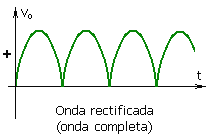DC
The direct current (abbreviated CC in Spanish, as well as DC in English) refers to the continuous flow of electrical charge through a conductor between two points of different potential and electrical charge, which does not change direction over time. Unlike alternating current, in direct current electrical charges always flow in the same direction. Although current is commonly identified continues with a constant current, any current that always maintains the same polarity is continuous, even if its intensity decreases as the charge is consumed (for example when an electric battery is discharged).
It is also said direct current when the electrons always move in the same direction, the flow is called direct current and it goes (by convention) from the positive to the negative pole.
History
Direct current was produced in the 1800s by Italian physicist Alessandro Volta's battery, his voltaic pile. The nature of why current flowed was not understood at the time. The French physicist André-Marie Ampère conjectured that current traveled in one direction, from positive to negative. When the French instrument maker Hippolyte Pixii built the first dynamoelectric generator in 1832, he discovered that when the magnet passed between the loops of wire every half turn, caused the flow of electricity to reverse, generating an alternating current. At Ampère's suggestion, Pixii then added a commutator, a type of "switch" in which the contacts on the shaft work with the contacts on the «brush» to produce direct current.
In the late 1870s and early 1880s, electricity began to be generated in power plants. These were initially configured to power arc light (a popular type of street lighting) which is powered by very high voltage direct current (usually higher than 3000 volts) or alternating current. This was followed by the widespread use of current low-voltage DC for indoor electrical lighting in businesses and homes after inventor Thomas Edison launched his incandescent-based electric "utility" in 1882. Because of the significant advantages of alternating current over direct current when using transformers to raising and lowering voltages to allow much longer transmission distances, direct current was replaced in the next few decades by alternating current in power delivery. In the mid-1950s, high-voltage direct current transmission was developed, and is now an option in lieu of long-distance high-voltage alternating current systems. For long-distance submarine cables (for example, between countries, such as the NorNed cable), this DC option is the only technically feasible option. For applications that require direct current, such as third rail power systems, the alternating current is distributed to a substation, which uses a rectifier to convert the power to direct current.
Conversion of alternating current to direct current
Many devices need direct current for their operation, particularly those that use active electronic components such as transistors and integrated circuits that constitute the basis of electronics (audiovisual equipment, computers, etc.). For this, power supplies are used that rectify and convert the voltage to a suitable one.
This rectification process is carried out by means of devices called rectifiers, formerly based on the use of vacuum tubes and currently, almost generally even in high power uses, by means of semiconductor diodes or thyristors.
Polarity
Generally, direct current devices do not usually incorporate protections against a possible change of polarity, which can cause irreversible damage to the device. To avoid this, and since the cause of the problem is the improper placement of the batteries, it is common for the devices to incorporate a diagram that shows how they should be placed; likewise, the contacts are distinguished by conventionally using a metallic spring for the negative pole and a plate for the positive pole. In devices with rechargeable batteries, the transformer-rectifier has such an output that the connection to the device can only be made one way, thus preventing polarity reversal. In the European systematic standard, the color black corresponds to the negative and red to the positive.
In the cases of large-scale installations, for example, telephone exchanges and other telecommunication equipment, where there is a centralized distribution of direct current for the entire equipment room, adequate connection and protection elements are used to avoid wrong connection of polarity.
Contenido relacionado
Electric capacitor
Hawking radiation
Reradiation



